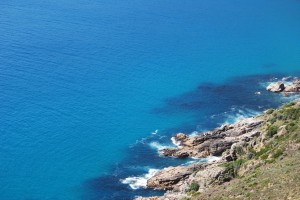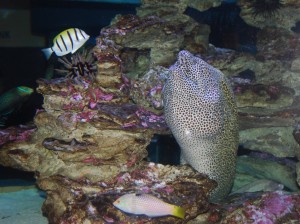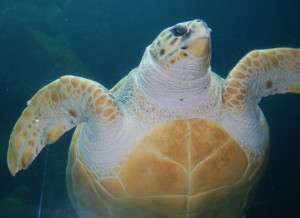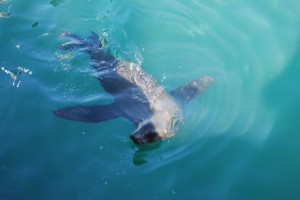CHAPTER < SIX - OCEAN OF LIFE
“The sea shapes the character of earth, governs climate and weather, regulates temperature, and comprises much of the biosphere – yet it remains largely unknown. It is not, however, untouched. Everywhere, the changes brought about by humankind are evident.” Marine scientist Dr Sylvia Earle
 Every living creature on Earth has a profound and formative connection to the ocean. We are bound to the sea by ancient and inseparable ties. Like fire, the ocean is an integral part of our deep collective consciousness, yet this connection goes way beyond human percipience. It is the very foundation of Earth’s life support system, for the sea shapes the character of the planet. Always in motion and responsive to the immense forces of the Earth’s rotation and the gravitational pull of the Sun and the Moon, the sea exerts its influence far and wide. Climate and weather patterns are powered in a continuous, interactive cycle of energy exchange between the atmosphere and the ocean. In summer heat is absorbed and in winter heat is released by the sea with ocean currents evening out air temperatures to a global mean temperature of 15 degrees centigrade.
Every living creature on Earth has a profound and formative connection to the ocean. We are bound to the sea by ancient and inseparable ties. Like fire, the ocean is an integral part of our deep collective consciousness, yet this connection goes way beyond human percipience. It is the very foundation of Earth’s life support system, for the sea shapes the character of the planet. Always in motion and responsive to the immense forces of the Earth’s rotation and the gravitational pull of the Sun and the Moon, the sea exerts its influence far and wide. Climate and weather patterns are powered in a continuous, interactive cycle of energy exchange between the atmosphere and the ocean. In summer heat is absorbed and in winter heat is released by the sea with ocean currents evening out air temperatures to a global mean temperature of 15 degrees centigrade.
The ocean also plays a vital role in planetary chemical cycles such as the carbon, nitrogen, phosphorus and oxygen cycles. It drives other important fundamental cycles such as the rainfall cycle, without which all life on the continental plates would perish. It shapes land configurations and the character of land formations. It holds much of the Earth’s biomass and is a reservoir of biodiversity. The ocean is also a heat sink that is capable of maintaining the Earth’s temperature for a period of time.
 Far from being featureless interlocking expanses of water held in vast uniform basins like tea in a smooth porcelain cup, the ocean represents one of the most diverse and extreme environments on the planet. Comprising 90 per cent of global habitats, marine environments are inhospitable worlds of perpetual darkness, near freezing water temperatures and water pressures that can crush a man to soup within seconds. On the other side of the coin or the blue divide, marine environments are also warmly benign and abundantly rich in colourful plant and animal life.
Far from being featureless interlocking expanses of water held in vast uniform basins like tea in a smooth porcelain cup, the ocean represents one of the most diverse and extreme environments on the planet. Comprising 90 per cent of global habitats, marine environments are inhospitable worlds of perpetual darkness, near freezing water temperatures and water pressures that can crush a man to soup within seconds. On the other side of the coin or the blue divide, marine environments are also warmly benign and abundantly rich in colourful plant and animal life.
The ocean is immensely powerful, capable of generating tsunami waves that can race along its surface at speeds of up to 800 kilometres per hour in wave lengths of over 150 kilometres. Geography of the ocean floor is in many places more spectacular than that of the continental plates, with mid-ocean trenches plunging further below the level of the ocean than Mount Everest soars above it. Yet it is also a fragile realm vulnerable to outside influences, most significant of which are the works of humankind.
Throughout the world coastal sites have been commandeered for human development because access to harbours, fisheries and recreational facilities enhances our lives. In order to maximise their positions, two-thirds of the 50 most densely populated cities in the world are coastal cities. Through the effects of population density; as well as runoffs from vehicles, sewage, forestry, farming, mining, dredging, industrial discharge, offshore drilling, shipping and oil tanker spillage, garbage disposal, beach litter and landfills, we have polluted our global sea to the point where in many parts of the world it is empty and devoid of life.
In some of these areas seawater has been transformed from a clear blue liquid, teeming with life, into a scummy brown sludge that has become lethal to the creatures that swim in it and the birds that skim atop it. It has become as barren, brown and lifeless as that cup of lukewarm tea, but the destructive agents of human activities have unfortunately not stopped there.
 Drift netting on the high seas has indiscriminately trapped sea birds, sea turtles, marine mammals such as dolphins, and other non-target or commercially non-viable species known as trashfish or bycatch. Commercially exploitable fish species have been caught in numbers that are bringing many species such as the Atlantic bluefin tuna to the point of extinction, which has forced fishermen in some regions to look further down the food chain to species that are in turn an important source of food to other species. And the mismanagement of fisheries, as well as the destruction of fish breeding and feeding grounds such as mangrove swamps, which provide a sheltering habitat for juvenile fish until they are able to survive in the open ocean, have added to the problem.
Drift netting on the high seas has indiscriminately trapped sea birds, sea turtles, marine mammals such as dolphins, and other non-target or commercially non-viable species known as trashfish or bycatch. Commercially exploitable fish species have been caught in numbers that are bringing many species such as the Atlantic bluefin tuna to the point of extinction, which has forced fishermen in some regions to look further down the food chain to species that are in turn an important source of food to other species. And the mismanagement of fisheries, as well as the destruction of fish breeding and feeding grounds such as mangrove swamps, which provide a sheltering habitat for juvenile fish until they are able to survive in the open ocean, have added to the problem.
Unaddressed, this downward spiral could have disastrous consequences for fish stocks worldwide. It could also adversely affect the livelihoods of millions of people employed in the global fishing industry. But pollution and overfishing aside, fish stocks have also become vulnerable to other factors. The depletion of ozone in the stratosphere and the resultant increase in solar ultraviolet radiation could affect the ability of fish larvae to reach maturity. Should ultraviolet radiation increase significantly as a result of further stratospheric ozone depletion, fish larvae in the top 10 metres of the sea could be killed off.
The Ocean and Global Warming
Every day the Earth receives enough radiant energy from the Sun to equal one million Hiroshima-sized atomic bombs. However, this output can vary, with an increase of 20 times more ultraviolet radiation during maximum sunspot activity. Solar energy is radiated as “visible” light. Of this energy, a third is reflected back into space immediately, whilst the remaining two-thirds is absorbed by the Earth and converted into heat. Plants, algae and some photosynthetic bacteria capture a tiny fraction of this energy for use in the photosynthetic process. The process of photosynthesis involves the fixing of carbon from carbon dioxide in the atmosphere and the release of oxygen as a by-product. This “harvesting” of light energy and conversion into chemical energy, has been the primary driver of life on our planet since life began.
 Of all photosynthesis that takes place on Earth, approximately 40 per cent is accounted for by the phytoplankton that lives in the top 100 metres of the sea, which is the zone penetrated by light from the surface. This activity generates about a third to a half of all global oxygen. Marine phytoplankton, like all living organisms, is sensitive to the destructive properties of ultraviolet rays, which render it less productive in terms of photosynthesis.
Of all photosynthesis that takes place on Earth, approximately 40 per cent is accounted for by the phytoplankton that lives in the top 100 metres of the sea, which is the zone penetrated by light from the surface. This activity generates about a third to a half of all global oxygen. Marine phytoplankton, like all living organisms, is sensitive to the destructive properties of ultraviolet rays, which render it less productive in terms of photosynthesis.
When ultraviolet radiation intensifies, phytoplankton moves from lighter to darker waters. As stratospheric ozone becomes depleted, allowing increased solar ultraviolet radiation to penetrate to the sea’s surface, photosynthesis slows down. The resultant build-up of carbon dioxide in the atmosphere over time could further increase the greenhouse effect, consequentially increasing global temperatures. This effect of ozone depletion is serious enough but its deleterious effect doesn’t stop there…